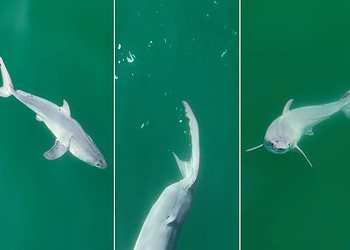
Shark attacks are exceedingly rare when you consider the sheer number of beachgoers that cross paths with these apex predators. Every year, there are no more than a couple dozen unprovoked shark attacks with an annual average of just four unprovoked fatalities. While every death is a tragedy, it’s worth bearing in mind that three times more people are killed by vending machines and about 30 times more are killed by falling coconuts than sharks.
What’s more, on the very rare occasion that sharks attack people, it may all be due to a case of mistaken identity. According to researchers from Australia, sharks can’t see very well, so they may not be able to distinguish swimmers at the water’s surface from their natural prey. In other words, sometimes humans just happen to look like their usual food.
Mistaken identity
This insight was gained after researchers looked at various silhouettes from the shark’s point of view. They recorded and compared video footage of swimmers, people paddling surfboards, and seals as a shark would see them from right below the water, with sunlight in the background.
“Surfers are the highest-risk group for fatal shark bites, especially by juvenile white sharks,” says lead author Dr. Laura Ryan, a post-doctoral researcher in animal sensory systems at Macquarie University’s Neurobiology Lab.
In order to truly put themselves in the sharks’ fins, the researchers employed their knowledge of the great whites’ retinal structure and brain visual systems to estimate their visual acuity. The focus was on the retina of great white juveniles, which are responsible for the majority of attacks on humans. These young sharks tend to have poorer vision than adults and are also more likely to venture inside habitats frequented by humans.
The footage was fed into modeling programs to simulate the way a paddling human or swimming seal might look through the eyes of a shark. “I didn’t realize being a scientist would involve quite so much coding,” Ryan said, which reminds us that modern science is becoming increasingly interdisciplinary and coding has become a must-have skill in any researchers’ toolkit, regardless of their field.
The analysis suggests that sharks, which are believed to be color blind, are ill-equipped to tell apart the silhouette shapes of humans or their motion cues from those of seals. As the sharks grow larger, their retinas also improve. Experience may also help adults better tell apart seals from humans, learning what’s good or bad to eat as they age, the researchers claim in their study published in the journal Royal Society Interface.
“We found that surfers, swimmers and pinnipeds (seals and sea-lions) on the surface of the ocean will look the same to a white shark looking up from below, because these sharks can’t see fine details or colors,” Ryan said.
It’s not sharks’ fault we look like food
These findings confirm a long-standing theory that great whites and other sharks responsible for rare attacks on humans do not actively seek us as prey.
Unfortunately for sharks, they have a bad rep due to their fierce appearance and skewed portrayals in popular media (i.e. Jaws films). Meanwhile, humans kill millions of sharks every year for their fins, cartilage, and oil. And our fear of sharks has also led to the widespread installation of shark nets and drumlines, which further threaten sharks, as well as other marine life. Great whites are now classed as endangered.






